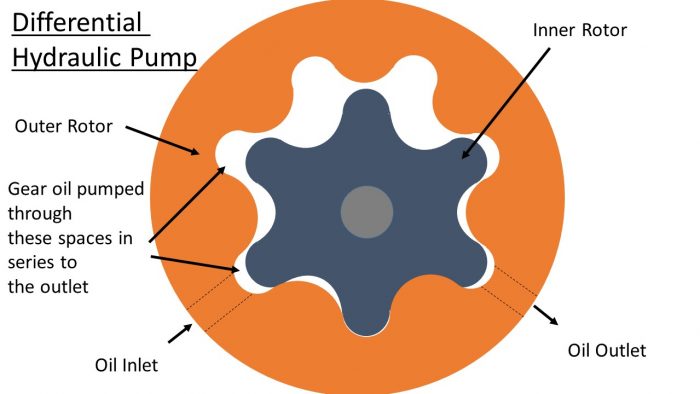How do hydraulic locking differentials work?
Another version of a locking differential is the hydraulic locking differential. As explained in the clutch-type locking differentials article, these have had different names depending on the manufacturer. These include Hydra-Lock and Vari-Lock but the basic function remains the same.
Hydraulic locking differentials contain a rotary style oil pump. This can consist of say a six-point internal rotor which can rotate inside an outer rotor housing containing say 7-cavities. These cavities contain gear oil. The motion of the internal gear points rotating into each of the cavities in series drives oil from the intake side of the rotor to the outlet. The direction of flow is kept consistent due to valves within the system. This ensuring inlet to outlet flow correctly no matter which direction the gearing rotates.
The hydraulic differential also contains a clutch pack similar to that described in a article entitled “Locking Differentials – Clutch Type’. Review the operation of clutch packs in that article. Differential drive is applied to the wheel by the clutch-pack method, however, the clutch pack is engaged in a different manner.

How does a hydraulic differential oil pump control drive?
The Internal rotary gear to one side axle and the other side axle is attached to the outer rotary gear. Under normal driving when no drive bias is required at the wheels, both gears rotate within the differential housing but do not rotate in relation to each other. This means no pressure is produced to pump the gear oil.
Upon traction loss, one axle is turning faster than the other. This causes the inner and outer rotary gears to turn at different speeds developing hydraulic pressure pumping the gear oil. The pressure is delivered to the ring diaphragm which in turn puts pressure on the clutch pack. Locking the clutch pack causes the axles to lock together and turn at the same rate. Upon gaining traction, the pumping stops and the differentials resume standard unlocked motion. Review what a differential does and why.
It is clear that differential locking is controlled by the pumping of the oil resulting in engagement of the clutch packs. It is easy to see that under regular turning, the amount of differential rotation of the axles will be slight and thus will not cause locking of the differential.
The gear oil which is pumped for engagement of the clutch pack is the same oil as is used for standard lubrication of the other axle components. It is supplied from the rear axle assembly sump.
In this series we have talked about what a differential is, what a standard differential is and more.
